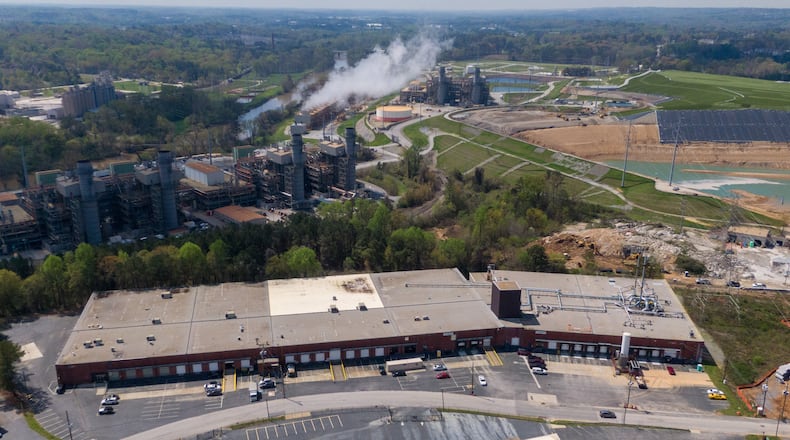More than two years after a Cobb medical sterilizer, Sterigenics, was flagged for emissions that could increase cancer risk, residents and local officials still don’t know whether air around the plant is safe to breath.
“We’re really wanting input from the state to help us not just collect the data, but help us understand the risk,” Smyrna Fire Chief Roy Acree told lawmakers this week during a meeting with the Cobb legislative delegation.
The public messages from federal and state regulators have been mixed.
Sterigenics’ emissions of ethylene oxide, a cancer-causing gas it is legally permitted to use for sterilization, came to public attention following a 2018 federal report that calculated levels of the gas above the threshold considered safe by the U.S. Environmental Protection Agency.
Subsequent air testing confirmed the gas was pervasive not only around the plant, but across the state at varying levels.
Officials from the Georgia Environmental Protection Division cited those results in calling for more testing to determine the “background” level of ethylene oxide. It’s unclear what the implications are for addressing specific sources of ethylene oxide if background levels are found to be higher than the EPA’s threshold for assessing risk, itself a screening tool with no enforcement mechanism.
So far, the state has periodically released the raw data from ongoing sampling, but its scientists have not clarified what they consider an acceptable level of ethylene oxide.
Meanwhile, Smyrna, Cobb and Atlanta partnered to contract their own air testing from a private firm, GHD.
Acree, the Smyrna fire chief, said that sampling found more ethylene oxide in the atmosphere after Sterigenics resumed operations in April following a seven-month hiatus to install new pollution controls. But officials have received contradictory interpretations of the results, he said.
“What level is acceptable? At what level does it have to reach for it to pose the risk to someone?” Acree said. He requested lawmakers: “Ask the EPD what their plans are to help better understand what that means.”
Kevin Chambers, a spokesperson for the EPD, said in an email that the agency recorded an increase in ethylene oxide around Sterigenics after it resumed operations, but that similar increases were also measured at “background” sites with no known source of ethylene oxide over the same period.
He wrote that “preliminary modeling” of the impact of Sterigenics’ new pollution controls indicates that ethylene oxide concentrations at nearby residences due to emissions from the plant are “now well below EPA’s unacceptable risk threshold.”
He went on to say that EPD relied on modeling, not air monitoring, to assess the impact of Sterigenics on residents due to “significant challenges” in collecting and assessing data.
“To facilitate analysis of the monitoring data, EPD continues to share our ambient monitoring data with the Georgia Department of Public Health, our federal partners at the Agency for Toxics and Disease Registry and U.S. Environmental Protection Agency (EPA) and the public,” he wrote.
Sterigenics says ambient ethylene oxide concentrations are not higher because its facility resumed operations. The company points to what it says are discrepancies between readings taken by GHD and EPD on the same day.
For its part, GHD appears to have lost some public trust after signing a contract with the American Chemistry Council, which has lobbied against ethylene oxide regulation that would affect Sterigenics and other sterilizers.
Over the summer, GHD representatives gave a presentation where they appeared to play down the significance of elevated ethylene oxide readings, according to several officials who attended, including Smyrna Mayor Derek Norton.
“They went a little bit off script and made some conclusions and some assumptions about what the data meant as far as the safety of people in and around Smyrna,” Norton said. “I wish that that wouldn’t have happened, but that is what happened.”
Norton’s comments were made during a recent meeting of the Air Quality Oversight Committee, which was formed last year. The mayor noted with dismay that GHD’s relationship with the American Chemistry Council was brought to his attention by local activists, implying it should have been disclosed by the company sooner.
In response to questions from The Atlanta Journal-Constitution, a spokesperson for GHD said the company “finds no conflict of interest between our work with the American Chemistry Council and our work with Cobb County.”
“GHD has performed consulting services relating to Ethylene Oxide (EtO) for decades in regards to community and workplace environments,” the spokesperson added.
The company also said its testing adhered to Environmental Protection Agency “compendium methods,” the standard methodology relied upon by federal regulators. Its methodology had been questioned at the committee meeting where Norton spoke.
State Rep. Erick Allen, D-Smyrna, said in his opinion GHD’s work for the chemical industry does represent a conflict of interest. He has pre-filed a bill for the coming legislative session that would require stricter oversight of facilities that use ethylene oxide in Georgia.
Allen said the fact that his constituents still don’t know whether their air is safe represents a failure of state and federal environmental regulators.
“You can sample the air all you want, but if there’s not an authority to tell you what’s good and what’s bad … then we’re going to be at the mercy of the companies,” Allen said. “What they’re going to say is acceptable is what they’re releasing.”
About the Author

